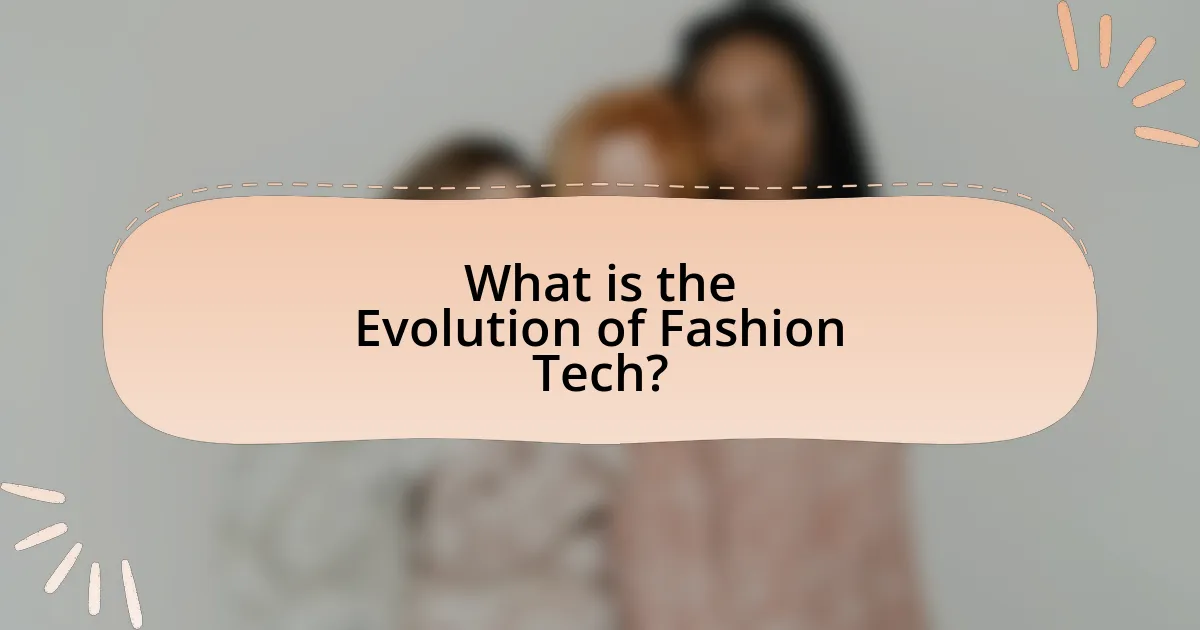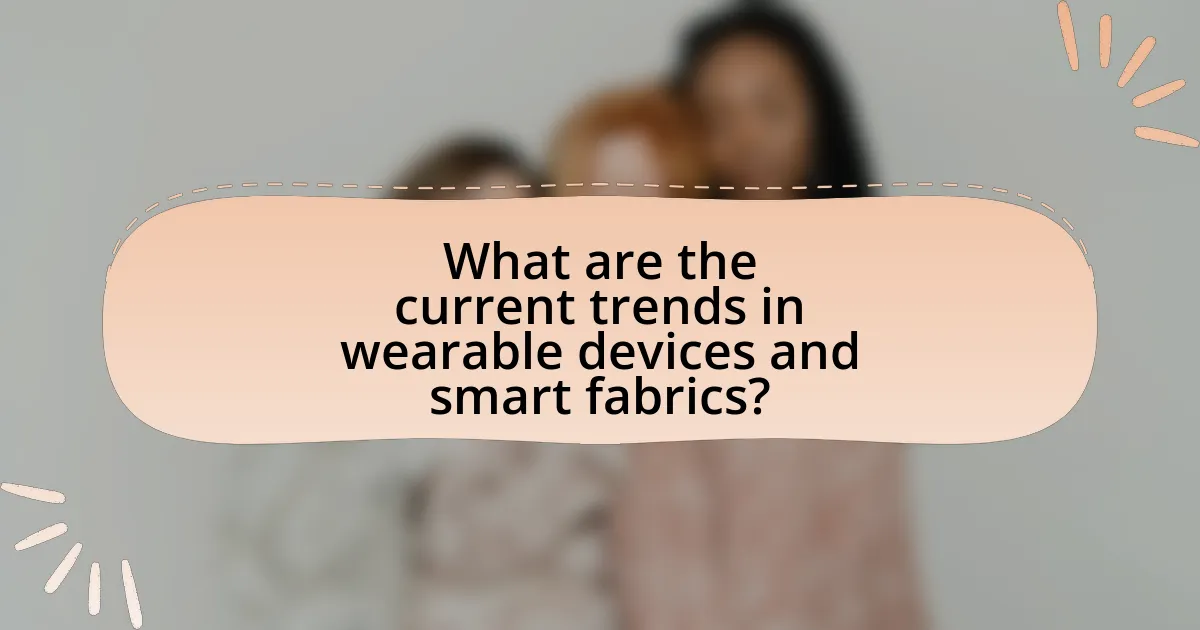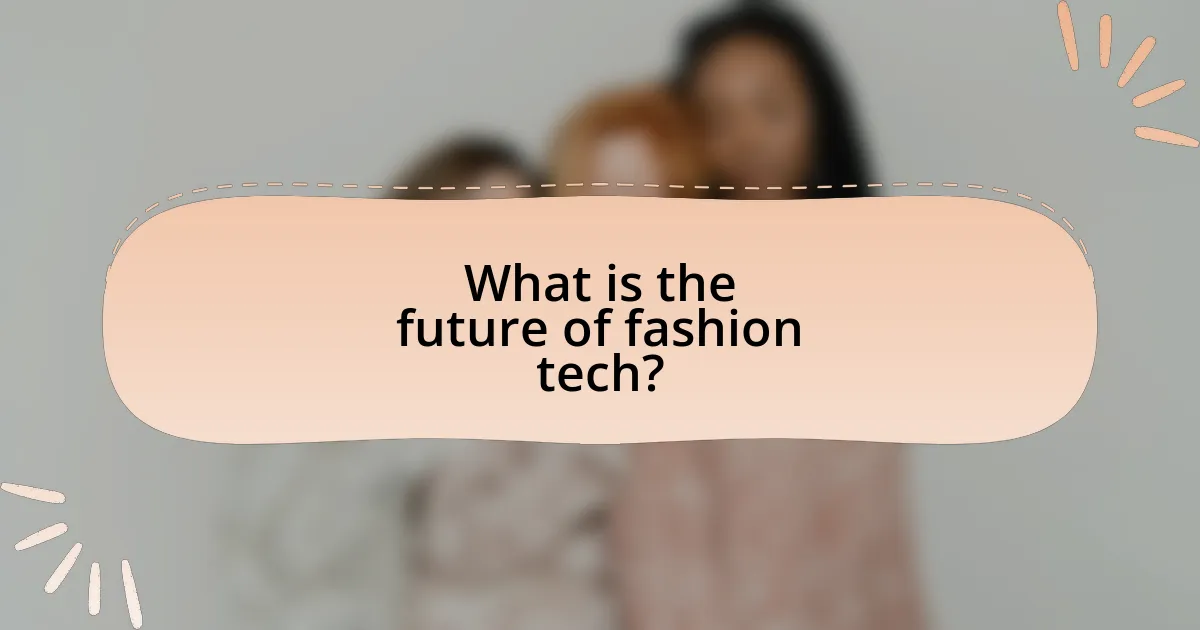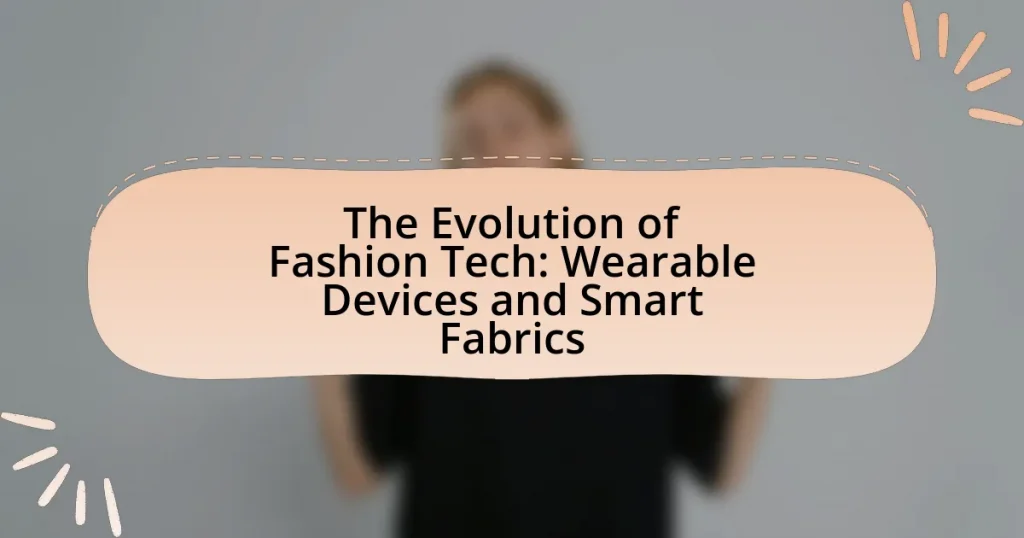The article focuses on the evolution of fashion tech, specifically highlighting the integration of wearable devices and smart fabrics into the fashion industry. It outlines the historical milestones that have shaped this field, from the introduction of synthetic fabrics to the rise of smart textiles and wearable technology. Key trends, such as advancements in health monitoring, sustainability, and consumer preferences, are discussed, along with the challenges faced by these technologies, including battery life and data privacy concerns. The future of fashion tech is explored, emphasizing the potential impact of emerging technologies and changing consumer behaviors on the industry.

What is the Evolution of Fashion Tech?
The evolution of fashion tech encompasses the integration of technology into clothing and accessories, significantly transforming the fashion industry. Initially, fashion tech began with the introduction of synthetic fabrics in the mid-20th century, which allowed for innovative designs and functionalities. The 2000s marked a pivotal shift with the emergence of wearable devices, such as fitness trackers and smartwatches, which combined style with health monitoring capabilities.
By the 2010s, advancements in smart fabrics emerged, enabling textiles to respond to environmental stimuli, such as temperature and moisture, enhancing user comfort and performance. Notable examples include the development of conductive threads and fabrics that can integrate sensors and LEDs, allowing garments to interact with digital devices.
The rise of augmented reality (AR) and virtual reality (VR) technologies further propelled fashion tech, enabling virtual try-ons and immersive shopping experiences. According to a report by McKinsey & Company, the global market for wearable technology in fashion is projected to reach $60 billion by 2023, highlighting the growing consumer demand for tech-integrated apparel. This evolution illustrates a continuous trend towards merging functionality with fashion, reshaping how consumers engage with clothing and accessories.
How has fashion tech transformed over the years?
Fashion tech has transformed significantly over the years, evolving from basic wearable devices to advanced smart fabrics integrated with technology. Initially, fashion tech focused on simple wearables like fitness trackers, which primarily monitored physical activity and health metrics. As technology advanced, innovations such as smart textiles emerged, allowing fabrics to interact with users and their environments, exemplified by developments like temperature-regulating materials and fabrics that can change color or pattern based on stimuli.
The market for wearable technology has grown exponentially, with a report from Statista indicating that the global wearable technology market was valued at approximately $116 billion in 2021 and is projected to reach $265 billion by 2026. This growth reflects the increasing integration of technology into everyday clothing, enhancing functionality and user experience. Additionally, collaborations between fashion brands and tech companies have led to the creation of products like smart jackets with built-in sensors and connected accessories, further illustrating the transformation of fashion tech into a dynamic and innovative field.
What historical milestones mark the evolution of fashion tech?
The evolution of fashion tech is marked by several key historical milestones, including the introduction of the Jacquard loom in 1804, which enabled programmable weaving and laid the groundwork for modern computing. In the 1960s, the development of synthetic fabrics like nylon and polyester revolutionized clothing materials, enhancing durability and versatility. The 1980s saw the emergence of wearable technology with devices like the first digital watches, which integrated electronics into fashion. The 2000s introduced smart textiles, such as those developed by companies like DuPont, which incorporated sensors and conductive fibers into fabrics. More recently, the launch of smartwatches in the 2010s, exemplified by the Apple Watch in 2015, has further integrated technology into everyday fashion, allowing for health monitoring and connectivity. Each of these milestones has significantly influenced the intersection of technology and fashion, shaping the industry as we know it today.
How have consumer needs influenced the development of fashion tech?
Consumer needs have significantly influenced the development of fashion tech by driving innovation towards functionality, sustainability, and personalization. As consumers increasingly seek convenience and enhanced experiences, fashion tech has evolved to incorporate features like smart fabrics that monitor health metrics and wearable devices that integrate seamlessly into daily life. For instance, the global wearable technology market was valued at approximately $116 billion in 2021 and is projected to grow, reflecting consumer demand for products that combine style with utility. Additionally, the rise in eco-conscious consumerism has led brands to develop sustainable materials and practices, such as biodegradable fabrics and energy-efficient production methods, aligning with consumer preferences for environmentally friendly options. This alignment between consumer expectations and technological advancements has propelled the fashion tech industry forward, ensuring that products meet the evolving demands of the market.
What role do wearable devices play in fashion tech?
Wearable devices play a crucial role in fashion tech by integrating technology with clothing and accessories to enhance functionality and user experience. These devices, such as smartwatches and fitness trackers, not only monitor health metrics but also provide connectivity and personalization options, thereby transforming traditional fashion into a more interactive and practical domain. For instance, the global market for wearable technology is projected to reach $60 billion by 2023, indicating a significant demand for these innovations in the fashion industry.
What types of wearable devices are currently available?
Currently, there are several types of wearable devices available, including smartwatches, fitness trackers, smart glasses, and health monitoring devices. Smartwatches, such as the Apple Watch and Samsung Galaxy Watch, offer features like notifications, fitness tracking, and app integration. Fitness trackers, like Fitbit and Garmin devices, primarily focus on monitoring physical activity, heart rate, and sleep patterns. Smart glasses, such as Google Glass and Microsoft HoloLens, provide augmented reality experiences and hands-free information access. Health monitoring devices, including continuous glucose monitors and smart clothing, track specific health metrics and provide real-time data to users. These categories reflect the diverse applications of wearable technology in daily life and health management.
How do wearable devices integrate with everyday fashion?
Wearable devices integrate with everyday fashion by combining technology with style, allowing users to monitor health metrics and receive notifications while maintaining aesthetic appeal. For instance, smartwatches and fitness trackers are designed to resemble traditional accessories, often featuring customizable bands and faces that match various outfits. According to a report by McKinsey & Company, the global market for wearable technology is projected to reach $62 billion by 2025, indicating a significant consumer interest in fashionable tech. This integration is further enhanced by collaborations between tech companies and fashion brands, resulting in products that prioritize both functionality and design, such as smart clothing that tracks physical activity while looking like regular apparel.
What are smart fabrics and how do they differ from traditional fabrics?
Smart fabrics are textiles that have been engineered to provide additional functionalities beyond traditional fabrics, such as sensing, actuation, and communication capabilities. Unlike traditional fabrics, which primarily serve aesthetic and comfort purposes, smart fabrics can interact with the environment and respond to stimuli, enabling applications in health monitoring, temperature regulation, and even energy generation. For instance, a study published in the journal “Advanced Materials” highlights how smart fabrics can integrate sensors to monitor physiological signals, demonstrating their advanced capabilities compared to conventional textiles.
What technologies are embedded in smart fabrics?
Smart fabrics incorporate various technologies such as conductive fibers, sensors, and microcontrollers. Conductive fibers enable electrical conductivity within the fabric, allowing for the integration of electronic components. Sensors embedded in smart fabrics can monitor physiological parameters like heart rate and temperature, providing real-time data. Microcontrollers process this data and can communicate with external devices, enhancing functionality. These technologies collectively enable applications in health monitoring, sports performance tracking, and interactive clothing, demonstrating the versatility and innovation within the realm of smart fabrics.
How do smart fabrics enhance functionality in clothing?
Smart fabrics enhance functionality in clothing by integrating technology that allows garments to respond to environmental stimuli and user needs. These fabrics can monitor body temperature, moisture levels, and physical activity, providing real-time feedback to the wearer. For instance, fabrics embedded with sensors can adjust insulation based on temperature changes, improving comfort and performance during various activities. Additionally, smart fabrics can incorporate features such as moisture-wicking, UV protection, and even health monitoring capabilities, which have been shown to improve athletic performance and overall well-being. The incorporation of conductive fibers and microelectronics enables these functionalities, making clothing not just a passive item but an active participant in the user’s lifestyle.

What are the current trends in wearable devices and smart fabrics?
Current trends in wearable devices and smart fabrics include the integration of advanced health monitoring features, increased focus on sustainability, and the rise of smart textiles that enhance user experience. Wearable devices now often incorporate sensors for tracking vital signs such as heart rate, blood pressure, and even glucose levels, reflecting a growing demand for health-centric technology. Additionally, brands are prioritizing eco-friendly materials and production methods, responding to consumer preferences for sustainable fashion. Smart fabrics are evolving to include functionalities like temperature regulation and moisture-wicking, enhancing comfort and performance in various environments. These trends are supported by market research indicating a projected growth in the wearable technology sector, expected to reach $60 billion by 2023, driven by innovations in both hardware and textile engineering.
How are fashion brands incorporating wearable technology?
Fashion brands are incorporating wearable technology by integrating smart fabrics and devices into their clothing and accessories. For instance, brands like Levi’s and Google collaborated to create the Jacquard jacket, which features touch-sensitive fabric that allows users to control their smartphones. Additionally, companies such as Under Armour have developed fitness apparel embedded with sensors that track biometric data, providing users with real-time performance insights. This trend reflects a growing emphasis on functionality and connectivity in fashion, as evidenced by the increasing number of partnerships between tech companies and fashion brands aimed at enhancing user experience through innovative designs.
What collaborations exist between tech companies and fashion designers?
Collaborations between tech companies and fashion designers include partnerships such as Apple and Hermès, which created the Apple Watch Hermès, combining luxury fashion with wearable technology. Another notable collaboration is between Google and Levi’s, resulting in the Jacquard jacket that integrates touch-sensitive technology for connectivity. Additionally, Adidas partnered with Parley for the Oceans to produce shoes made from recycled ocean plastic, showcasing a blend of sustainability and innovation. These collaborations illustrate the merging of technology and fashion, enhancing functionality while maintaining aesthetic appeal.
How are consumer preferences shaping these trends?
Consumer preferences are significantly shaping trends in fashion tech, particularly in the adoption of wearable devices and smart fabrics. As consumers increasingly prioritize functionality, comfort, and sustainability, brands are responding by integrating advanced technology into their products. For instance, a survey by McKinsey & Company found that 67% of consumers are willing to pay more for sustainable products, prompting fashion tech companies to innovate with eco-friendly materials and energy-efficient devices. Additionally, the demand for personalized experiences has led to the development of smart fabrics that adapt to individual needs, such as temperature regulation and fitness tracking. This shift in consumer behavior is driving the evolution of fashion tech, as companies strive to meet the expectations of a more informed and conscientious customer base.
What challenges do wearable devices and smart fabrics face?
Wearable devices and smart fabrics face several challenges, including battery life limitations, comfort and fit issues, data privacy concerns, and integration with existing technologies. Battery life is a critical issue, as many wearable devices require frequent recharging, which can hinder user adoption. Comfort and fit are essential for user satisfaction; if a device is uncomfortable, users are less likely to wear it consistently. Data privacy is a significant concern, as these devices often collect sensitive personal information, raising questions about how that data is stored and used. Lastly, integration with existing technologies can be complex, as compatibility issues may arise between different devices and platforms, complicating user experience and functionality.
What are the technical limitations of current wearable technology?
Current wearable technology faces several technical limitations, including battery life, data accuracy, and connectivity issues. Battery life remains a significant challenge, as many devices require frequent recharging, limiting their usability; for instance, smartwatches often last only one to two days on a single charge. Data accuracy can also be compromised, particularly in health monitoring devices, where factors like sensor placement and environmental conditions can lead to inconsistent readings. Additionally, connectivity issues arise from reliance on Bluetooth or Wi-Fi, which can result in lag or disconnection, affecting real-time data transmission. These limitations hinder the overall effectiveness and user experience of wearable devices in the fashion tech landscape.
How do privacy concerns affect the adoption of wearable devices?
Privacy concerns significantly hinder the adoption of wearable devices. Many potential users fear that these devices may collect sensitive personal data, such as health metrics and location information, which could be misused or inadequately protected. A survey conducted by the Pew Research Center in 2021 revealed that 60% of Americans expressed concern about how their data would be used by companies, indicating a strong apprehension regarding privacy. This fear can lead to reluctance in purchasing or using wearable technology, as individuals prioritize their data security over the benefits these devices offer.

What is the future of fashion tech?
The future of fashion tech is characterized by the integration of advanced technologies such as artificial intelligence, augmented reality, and sustainable materials into wearable devices and smart fabrics. This evolution is driven by consumer demand for personalized experiences and eco-friendly solutions. For instance, the global smart clothing market is projected to reach $5.4 billion by 2024, indicating significant growth and investment in this sector. Additionally, innovations like 3D printing and blockchain for supply chain transparency are set to redefine production processes and enhance consumer engagement. These advancements will not only improve functionality and comfort but also promote sustainability in the fashion industry.
How will advancements in technology impact fashion tech?
Advancements in technology will significantly enhance fashion tech by enabling the development of innovative wearable devices and smart fabrics. These technologies will allow for improved functionality, such as health monitoring through integrated sensors, which can track vital signs and physical activity in real-time. For instance, a study by the Consumer Technology Association in 2021 indicated that 30% of consumers expressed interest in smart clothing that could monitor health metrics. Additionally, advancements in materials science will lead to the creation of fabrics that can change color or temperature based on environmental conditions, enhancing user experience and personalization. This integration of technology into fashion not only increases the utility of clothing but also drives sustainability by optimizing resource use in production processes.
What emerging technologies could revolutionize wearable devices?
Emerging technologies that could revolutionize wearable devices include advanced sensors, flexible electronics, and artificial intelligence. Advanced sensors, such as biosensors, enable real-time health monitoring by detecting physiological signals like heart rate and glucose levels, which can lead to improved health management. Flexible electronics allow for the creation of lightweight, comfortable wearables that can conform to the body, enhancing user experience and functionality. Artificial intelligence enhances wearables by providing personalized insights and predictive analytics based on user data, improving decision-making and health outcomes. These technologies are supported by ongoing research and development in fields such as materials science and machine learning, indicating their potential impact on the future of wearable devices.
How might consumer behavior evolve in response to fashion tech innovations?
Consumer behavior is likely to evolve towards increased demand for personalized and sustainable fashion as a result of fashion tech innovations. Wearable devices and smart fabrics enable consumers to track their health and preferences, leading to a shift in purchasing decisions that prioritize functionality and individual needs. For instance, a study by McKinsey & Company found that 66% of consumers are willing to pay more for sustainable brands, indicating a growing trend towards eco-conscious choices influenced by technology that promotes sustainability. Additionally, the integration of augmented reality in shopping experiences allows consumers to visualize products better, enhancing their engagement and likelihood of purchase. This evolution reflects a broader trend where technology not only enhances the shopping experience but also aligns with consumer values around personalization and sustainability.
What practical tips can consumers consider when choosing wearable devices?
When choosing wearable devices, consumers should prioritize compatibility with their existing technology, such as smartphones and operating systems. This ensures seamless integration and functionality. Additionally, consumers should assess the device’s battery life, as longer battery life enhances usability and convenience. Another important factor is the range of features offered, including fitness tracking, health monitoring, and connectivity options, which can significantly impact the device’s overall value. Furthermore, consumers should consider the comfort and design of the wearable, as a well-fitting and aesthetically pleasing device is more likely to be used consistently. Lastly, reading reviews and checking for warranty and customer support options can provide insights into the device’s reliability and the manufacturer’s commitment to quality.
How can consumers assess the functionality of wearable devices?
Consumers can assess the functionality of wearable devices by evaluating their features, compatibility, and user reviews. Key features to consider include health tracking capabilities, battery life, and connectivity options, which directly impact the device’s performance. Compatibility with smartphones and other devices is crucial for seamless integration, as highlighted by a study from the International Journal of Human-Computer Interaction, which found that 75% of users prioritize compatibility when choosing wearables. User reviews provide real-world insights into the device’s reliability and ease of use, with platforms like Amazon and tech review sites offering extensive feedback from actual users.
What factors should be considered for comfort and style in wearable tech?
Comfort and style in wearable tech should consider fit, material, aesthetics, and functionality. A proper fit ensures that the device does not cause discomfort during use, which is crucial for user satisfaction. The choice of materials, such as breathable fabrics or lightweight components, enhances comfort by reducing irritation and allowing for better skin interaction. Aesthetics play a significant role, as consumers often prefer designs that align with their personal style, influencing their willingness to wear the technology regularly. Lastly, functionality must not compromise style; wearable tech should seamlessly integrate into daily life while providing practical benefits, such as health monitoring or connectivity. These factors collectively contribute to the overall user experience and acceptance of wearable technology.




